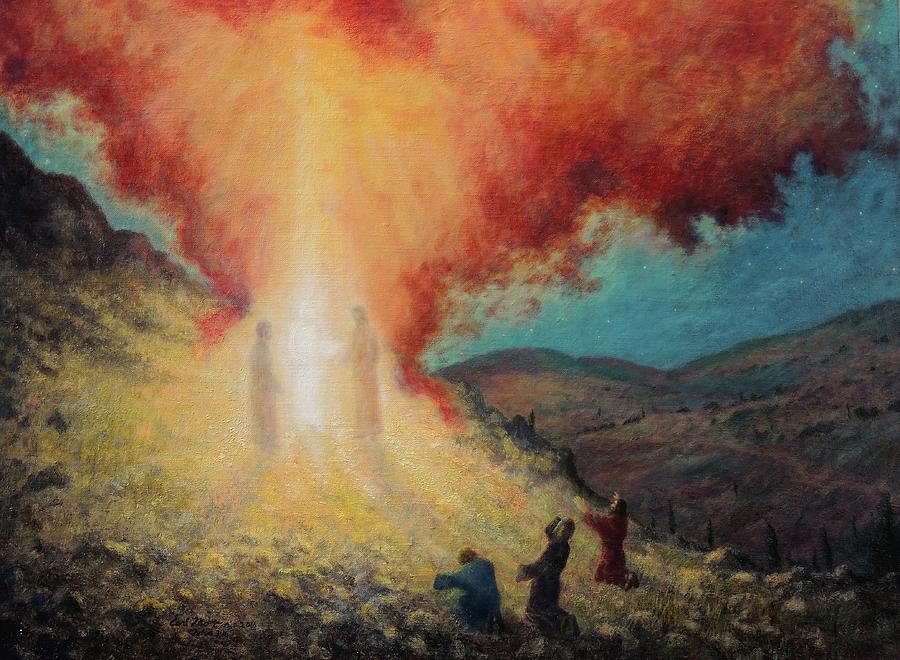
by Ian Paul – February 21, 2022
The gospel reading is Luke 9.28–36, the account of the Transfiguration, with the option of continuing to read the episode that follows immediately on the descent from the mountain. There are some important things to note in relation to this passage as we think about preaching on it.
All three Synoptic accounts place this immediately after Peter’s confession of Jesus at Caesarea Philippi, where Jesus then starts to talk about his betrayal and death. They seem to want us to hold these two truths together: that the Son of Man is one who is humble and obedient even to death; and yet he is also the one spoken of in Daniel 7 where he comes to the Ancient of Days and receives a kingdom that will never end. Both of these are true about Jesus, and both must be held together. This is made clear by the final saying of Jesus in the previous pericope (section):
Amen I say to you, some who are standing here will not taste death before they see the kingdom of God (Luke 9.27).
Note that Mark adds ‘with power’ in his parallel (Mark 9.1), and Matthew uses the phrase ‘the Son of Man coming in his kingdom’ (Matt 16.28); this is the erchomenos language of Matt 24 referring to the Son of Man coming to the Ancient of Days, not the parousia language of Jesus’ return at the End, so we can see that all three understand Jesus’ comment as a reference to his exaltation and ascension, and the giving of the Spirit at Pentecost followed by the preaching of the gospel.
All three gospels then follow this by specifying the short time period of about a week between that and the revelation on the mountain (the difference between Luke’s ‘eight days’ and Matthew and Mark’s ‘six days’ being the difference between inclusive and exclusive ways of counting), and this is the only place in Matthew where he is so specific about a time period. The ‘some’ makes sense when we see Jesus taking with him only his inner circle of Peter, James and John, as he does later at Gethsemane. John then talks of having ‘seen [Jesus’] glory’ (John 1.14) and 2 Peter 1.17–18 also includes testimony to this incident. (It is also interesting to note the way that Paul connects issues of glory and suffering with Moses’ experience on Sinai and the language of being ‘transformed’, using the same verb metamorpheo that translated ‘transfigured’ in Matthew and Mark, in 1 2 Cor 3.18.)
Mikeal Parsons describes this narrative as having the form of a ‘dream-vision’ (and notes that Matthew uses the term horama, vision or sight, in Matt 17.9) but there is no sense that any of the gospel writers think of it as something different in kind from the events before and after. Luke is alone in specifying that Jesus took the three with him ‘to pray’; prayer is one of the distinctive focusses of Luke’s narrative (notice the Lukan mention of prayer earlier in the chapter in Luke 9.18and the later mention of Jesus’ praying as the context for teaching the Lord’s Prayer in Luke 11.1).
The language of ‘transfiguration’ (which derives from the Latin of the Vulgate here), is rather unhelpful. There is a ‘transformation’, but in contrast to the other incident of divine revelation from heaven at Jesus’ baptism in Luke 3, the perspective is that of the disciples, not of Jesus himself. So he is transformed ‘before them’ and Moses and Elijah appear ‘before them’. In fact, the whole emphasis is on the disciples (count how many times ‘they’ or ‘them’ occur). As is clear from the ending of the episode, where Jesus is alone, the point is not a change in Jesus, but a change in their understanding of who he is. The full truth will only come after his death and resurrection, but these privileged three have a foretaste, an anticipation ahead of time, which will only really make sense later.
The three Synoptics vary considerably in the exact language that they use to describe Jesus’ appearance; it is difficult to know what it would have looked like had we been there and filmed it on our iPhones, but what the gospel writers want us to know is its significance. The language Matthew uses focusses on divine presence, picking up Old Testament language of God as clothed in light, but Luke draws more parallels with Moses’ face shining (Ex 34.29) and this fits with Moses also taking three named persons up a mountain with him (along with 70 others, Ex 24.1, 9), and God’s voice coming from an overshadowing cloud (Ex 24.15–18).
The appearance of Moses and Elijah is introduced by Luke in a way that connects with other parts of his story. The phrase ‘And behold, two men’ (Luke 9.30) also occurs at the empty tomb (Luke 24.4) and at the ascension in Acts 1.10; we might translated the term ἰδοὺ as ‘take note!’ to capture its impact. This does not imply that the men at the same characters, but the phrase connects the three moments (transfiguration, resurrection and ascension) when Jesus’ divine identity is most clearly displayed. In popular readings, Moses and Elijah are often thought to represent the law and the prophets. But Elijah was not one of the writing prophets, and in Jewish tradition the mysterious circumstances of Moses’ death on Mount Nebo (Deut 34.5–6) and Elijah’s being taken up to God on a chariot of fire (2 Kings 2.11) earned them the title of ‘the deathless ones’. Their presence with Jesus is an anticipation of Jesus’ own conquest of death. They also signify the rescuing of God’s people from slavery to freedom (Moses) and the call to faithfulness (Elijah); both encountered God on the mountain (Sinai/Horeb) and both experienced rejection by and suffering at the hands of God’s own people, which makes the connection between the suffering Jesus has just spoken of and the glory which he will receive.
The account of their conversation in Luke 9.31–33 is unique to the third gospel; looking at the three passages in parallel very clearly shows the gap in Matthew and Mark where Luke includes his commentary on both the conversation of Jesus with Moses and Elijah and the sleep of the disciples. The language of Jesus’ ‘departure’ uses the Greek term exodus which both connects Jesus with Moses once more, but also ties this episode into the wider narrative, both looking back to the hope of deliverance in the Benedictus in Luke 1, and anticipating everything Jesus is to ‘accomplish’ in Jerusalem, and so once more confirms Luke’s focus on the importance of Jerusalem. The sleepiness of Peter and his companions anticipates their sleepy failure in Gethsemane (Luke 22.45).
Peter’s clumsy interjection, offering to make shelters and capture the moment, is ameliorated by both Mark and Luke in their explanation that he didn’t know what to say in the context of such an unsettling experience. He appears to want the experience to persist, or perhaps to try and make his own contribution when he really should have been simply attending to what was before him. (There is a possibility that Peter’s action reflects a Jewish tradition arising from Ps 43.3: ‘Send your light and your truth; let them bring me to your holy mountain and your tents’; in a later Midrash, the ‘light’ is understood to be Elijah and the ‘truth’ to be the anticipated Messiah.) He has not yet understood that this is a momentary drawing back of the curtain, giving him and the other two a glimpse of the heavenly reality of who Jesus really is, but that this is not the end of the story—yet.
They are covered with a ‘cloud full of light’; all through the story of scripture, clouds signify the presence of God (which is more easy to understand if you live in a country where the sky is blue for much of the time) and this evokes fear as well as awe (compare Ezek 1.4). The voice of God here echoes what was said at Jesus baptism (Luke 3.22), and this time there is no ambiguity as to whether the words are addressed to Jesus or to those watching—the audience of the three disciples are commanded or invited to listen to him. Jesus is not simply one like Moses or Elijah; he far transcends them as the Son of the Living God, the one in whom we encounter God’s own presence and glory. The words also echo Is 42.1, making again the connection between suffering and glory.
Luke moves on to the next episode of Jesus’ ministry, but both Matthew and Mark fill out the details of the disciples’ puzzlement. They still do not understand the significance of this vision or insight—and indeed, they will not until they have begun to make sense of Jesus’ death and resurrection. They are slowly putting together the pieces of the jigsaw puzzle of Jesus’ identity and how he is fulfilling the purposes of God. We are like those who have been given the puzzle box, with the finished picture on the outside so that we can see with hindsight where the pieces fit together.
This leaves two major issues as a challenge for contemporary discipleship. The first arises from the juxtaposition of this episode with what immediately preceded it, and the links Luke makes by use of his ‘Behold, two men…!’. The transfiguration, the resurrection, and the ascension are linked together, but in every case the moment of glory follows from and arises out of a revelation or a moment of suffering. We find these two themes intertwined all through the Scriptures, including in the stories of Moses and Elijah themselves. John sums it up neatly in Revelation 1.9: ‘I, John, your brother and companion in suffering, kingdom, and patient endurance that are in Jesus…’ Some object to the idea that ‘suffering’ is ours ‘in Jesus’, but Luke leaves us in no doubt. Are we ready to embrace both suffering and glory? And in those hard and testing times will we continue to look to the exalted Jesus and allow our hardship to be take up in praise?
Secondly, in any relationship, it takes time to understand and get to know someone, and even with people we know well, there are times when we gain particular insight into their character by something they do or say which gives us fresh insight into who they are. This seems to be how the Transfiguration functions for the three disciples, and offers key insight into who Jesus is. Is it an insight we have yet gained for ourselves? All too often we end up choosing which aspects of Jesus we like or find convivial, and ignore other aspects of who he is, thus making Jesus in our own image. But, just as with the first disciples, he will not allow us to pick and choose; if he is not Lord in all the ways he claims, he is not Lord at all.

Ian Paul is a theologian, author, speaker, academic consultant. Adjunct Professor, Fuller Theological Seminary; Associate Minister, St Nic’s, Nottingham; Managing Editor, Grove Books; member of General Synod.
